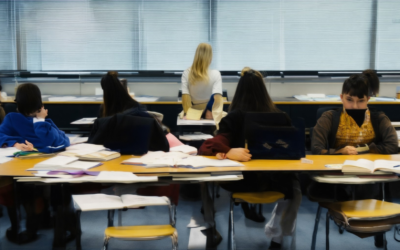High school is a pivotal phase in one’s educational journey, marked by challenges, growth, and preparation for the future. Navigating this period successfully requires a blend of academic rigor, personal resilience, and strategic planning. Whether it’s mastering complex subjects, staying organized, or balancing social life with responsibilities, high school presents a unique set of obstacles that demand careful navigation. This comprehensive guide dives into the essential strategies, tools, and resources designed to support students in thriving during their high school years. From academic excellence to mental well-being, we explore actionable tips, cutting-edge technologies, and valuable insights to help students achieve their full potential. By addressing key areas such as staying ahead in schoolwork, leveraging effective organizational tools, understanding common challenges, and preparing for the future, this guide serves as an invaluable roadmap for high school success. Discover how to maximize your high school experience and lay a strong foundation for whatever comes next.
How to Be Academically Successful in High School
To achieve academic success in high school, it’s essential to adopt a strategic and proactive approach. Below are proven strategies to help you excel academically:
1. Set Clear and Realistic Goals
- Define short-term and long-term academic objectives. Whether aiming for specific grades or course credits, having a roadmap will guide your efforts.
- Prioritize subjects aligned with your interests and career aspirations to stay motivated.
2. Stay Organized and Manage Time Effectively
- Use tools like planners or digital calendars to track assignments and deadlines.
- Create a study schedule that balances schoolwork with extracurricular activities.
- Break tasks into smaller, manageable steps to avoid last-minute stress.
3. Seek Help When Needed
- Don’t hesitate to ask teachers, classmates, or mentors for support when struggling with a subject.
- Join study groups or study clubs to benefit from collaborative learning and shared resources.
4. Balance School with Social Life
- Allocate time for hobbies and relaxation to maintain mental well-being.
- Avoid overcommitting to activities that hinder academic performance.
5. Leverage Available Resources
- Utilize school libraries, online databases, and academic platforms like Enroll Maven for valuable learning materials and guides.
- Attend workshops, tutoring sessions, and academic fairs to discover additional resources.
6. Develop Good Study Habits
- Find a quiet, distraction-free space for studying.
- Practice consistent study methods, such as active reading and summarizing key concepts.
- Regular review and practice tests to reinforce learning.
7. Maintain a Positive Attitude
- Embrace challenges as opportunities for growth rather than setbacks.
- Cultivate resilience to overcome obstacles and stay focused on your goals.
By implementing these strategies, you can create a strong foundation for academic success in high school. Remember, consistency, determination, and a willingness to seek help are key to achieving your full potential.
Which is the hardest year in high school?
The hardest year in high school is typically considered to be juniior year . This is due to the increased academic workload, the pressure of preparing for college admissions, and the added responsibilities of extracurricular activities and social obligations.
During junior year, students often face:
- Increased Course Load: Many students take more advanced courses, such as Advanced Placement (AP) or International Baccalaureate (IB) classes, which require significant time and effort to excel.
- College Application Process: Juniors are busy completing college applications, writing essays, and preparing for standardized tests like the SAT or ACT.
- Social Pressures: Juniors may also be dealing with social challenges, such as maintaining friendships, managing schoolwork, and participating in extracurricular activities.
While senior year can also be challenging, it often feels less overwhelming because students have fewer requirements and more flexibility in their schedules. However, junior year remains the most commonly cited difficult year due to its multifaceted demands.
Most Useful App for High School Students
High school students have a lot on their plates, from balancing academics to staying connected with friends. The right app can make their lives easier, more organized, and even a bit more fun. Here are some top picks:
- MyStudyLife – Perfect for organizing schoolwork, this app helps track assignments, schedule classes, and manage exams. It’s great for staying on top of your academic game.
- Zoho Notes – A versatile note-taking app that allows collaboration with classmates, making it ideal for group projects and shared learning experiences.
- Breeze – An all-in-one app that combines messaging, calendar, and task management. It keeps everything synced and accessible, making it easy to stay connected and organized.
- Todoist – A customizable to-do list app that helps manage homework and deadlines. Its flexibility makes it suitable for various learning styles.
- Anki – A powerful flashcard app that’s perfect for studying subjects like biology, chemistry, and history. It’s known for its effectiveness in boosting memory retention.
- Habitica – A habit-forming app that helps students develop good study habits and time-management skills. It tracks progress and keeps users motivated.
- Quizlet – A popular flashcard app that lets students create and share study sets. It’s great for collaborative learning and tracking progress over time.
- Mint for Teens – A financial literacy app that teaches budgeting and money management. It’s a valuable tool for students preparing to handle their own finances post-high school.
While each of these apps excels in specific areas, Breeze stands out for its ability to combine multiple functionalities into one platform. Whether you’re looking to stay organized, communicate with classmates, or manage your schedule, Breeze offers a seamless experience tailored for high school students.
What High School Students Need Most
High school students encounter a variety of challenges that require support in multiple areas. Here’s a breakdown of what they need most:
- Academic Support: Access to resources, study tips, and strategies to manage coursework and prepare for exams.
- Social and Emotional Well-being: Resources for mental health, including counseling services and programs to foster positive relationships.
- College Readiness: Guidance on college applications, financial aid, and future planning to ensure they’re prepared for life after high school.
- Technology Access: Reliable devices and internet connectivity to support online learning and research requirements.
- Safe Environments: Programs focused on anti-bullying and cybersecurity to protect students both physically and digitally.
- Extracurricular Opportunities: Access to clubs, sports, and other activities that encourage skill development and personal growth.
- Nutrition and Health: Information and programs promoting healthy eating habits and regular physical activity to enhance overall well-being.
- Career Exploration: Workshops and experiences connecting students with professionals in various industries to explore career pathways.
High School School Supply Must Haves
- Backpack or tote bag for carrying books and essentials
- spiral-bound notebook or composition book
- Pencil with eraser or graphite pencil
- Binder with dividers for organizing papers
- Planner or academic calendar for scheduling
- Lunchbox or reusable food container
- Water bottle or hydration jug
- Uniform or casual school attire
- Calculator for math and science classes
- Charger or power bank for electronics
- Desk organizer or tray for workspace
- Binder covers or decorative inserts
- Art supplies kit (if needed)
- Sports gear or equipment for physical education
- Reading material or e-reader for downtime
- Technology device (laptop/tablet/smartphone)
- First aid kit or band-aids
- Cleaning supplies (hand sanitizer, wipes, tissues)
What Do High Schools Spend the Most Money On?
High schools allocate their budgets across various critical areas, with the majority focused on teacher salaries and benefits, which account for the highest expenditure. This is due to the significant role teachers play in education. Below is a breakdown of how high schools distribute their funds:
-
Teacher Salaries and Benefits :
The largest portion of a high school’s budget goes toward compensating teachers and providing them with benefits. This includes salaries, pensions, health insurance, and retirement plans. -
Operational Costs :
Expenses related to maintaining school operations, such as utilities, janitorial services, and facility maintenance, are substantial. Additionally, schools invest in technology, such as computers and software, to enhance learning experiences. -
Curriculum Development and Resources :
Funds are allocated for textbooks, instructional materials, and other resources needed to support teaching and learning. Professional development for teachers is also a priority to ensure they remain updated on educational advancements. -
Support Staff :
Costs associated with counselors, librarians, and administrative personnel are significant. These roles provide essential services that complement classroom instruction and support student well-being. -
Infrastructure and Facilities :
Maintenance and improvements to buildings, playgrounds, and athletic facilities are important for a safe and functional learning environment. -
Transportation :
Public schools often spend on buses and other transportation services to ensure students can attend classes safely and on time. -
Intervention Programs :
Funding is allocated for programs aimed at supporting students who may need additional help, such as tutoring or mental health services. -
Food Services :
Budgets include expenses related to preparing and serving meals, covering labor costs for cafeteria staff and food procurement.
By prioritizing these areas, high schools aim to create a supportive and effective learning environment for students.







0 Comments